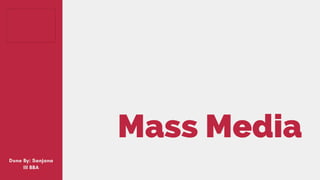
Mass media and its impact on society
- 1. Mass Media
- 2. DEFINING MASS MEDIA Mass media means technology that is intended to reach a mass audience. It is the primary means of communication used to reach the vast majority of the general public. The most common platforms for mass media are newspapers, magazines, radio, television, and the Internet.
- 3. TYPES OF MASS MEDIA Mass Media Can be Classified into Four main types: • Print Media (Newspaper, Magazines) • Broadcast Media (TV, Radio) • Outdoor or Out of Home (OOH) Media • Internet
- 4. FUNCTIONS OF MASS MEDIA The mass media not only report the results of public opinion surveys conducted by outside organizations but also increasingly incorporate their own polls into their news coverage. More important, newspapers and television help shape public opinion as well. Resear ch has shown that the positions Americans take on critical issues are influenced by the media, especially when the media air divergent vie ws and provide in-depth analysis. • Public Opinion The term political agenda is broader in scope than the term public opinion, and it refers to the issues Americans think are t he most important and that government needs to address. A person's perception of such matters as crime, civil rights, the economy, immigration, and welfare are affected by the manner and extent of media coverage. Studies indicate that a correlation exists between the significance people assign a problem and the frequency and amount of space or time newspapers, magazines, and television give to it. • Political agenda The mass media is the vehicle through which the government informs, explains, and tries to win support for its programs and p olicies. President Franklin Roosevelt's "fireside chats" used radio in this manner. Today, the major networks do not always give the p resident desired airtime if they believe the purpose is essentially political. If they do grant the time, the opposition party usually has the opportunity to rebut what the president says or present its own views on a topic immediately after the president speaks. • Link between the government and the people
- 5. From muckraking early in the century to today's investigative reporting, an important function of the mass media is to bring to the attention of the American people evidence of corruption, abuse of power, and ineffective policies and programs. Watergate would have remai ned just another burglary buried in the back pages of The Washington Post had Carl Bernstein and Bob Woodward not dug into the story. Although the media are often accused of having a "liberal bias" (and, indeed, surveys show most journalists to be liberal Democrats), all presidential administrations face close scrutiny from print and broadcast journalists. • Government watchdog The mass media, most significantly through its news, reporting, and analysis, affects what and how we learn about politics and our own political views. Along with family, schools, and religious organizations, television also becomes part of the process by which people learn society's values and come to understand what society expects from them. In this regard, the impact comes primarily from entertainment programming. Television's portrayal of minorities and women, family relations, and the place of religion in American life is considered to be a powerful influence on our attitudes.Some people believe that Americans, especially children, imitate behavior observed in media communications. They are, therefore, concerned about the quantity of sex and violence on TV. This theory of behavior may be naive, and certainly it lacks consistent or weighty scientific evidence. Nevertheless, the perspective is a significant political force, because it links social conservatives wh o disapprove of sexual promiscuity with social liberals who find America's gun culture distasteful. Both the legislative and executive branches have pressured networks to clean up what former Vice President Al Gore called the "cultural wasteland." • Socialization
- 7. The mass media occupy a high proportion of our leisure time: people spend, on average, 25 hours per week watching television, and they also find time for radio, cinema, magazines and newspapers. For children, watching television takes up a similar amount of time to that spent at school or with family and friends. While school, home and friends are all acknowledged as major socializing influences on children, a huge debate surrounds the possible effects of the mass media and findings both in favour and against effects are controversial. The question of effects is typically raised with an urgency deriving from a public rather than an academic agenda and with a simplicity which is inappropriate to the complexity of the issue (we do not ask of other social influences, what is the effect of parents on children or do schools have an effect which generalizes to the home or do friends have positive or negative effects?).
- 8. The possibility of media effects is often seen to challenge individual respect and autonomy, as if a pro-effects view presumes the public to be a gullible mass, cultural dopes, vulnerable to an ideological hypodermic needle, and as if television was being proposed as the sole cause of a range of social behaviours. Such a stereotyped view of research tends to pose an equally stereotyped alternative view of creative and informed viewers making rational choices about what to see. Overview articles often describe a history of progress over the past seventy years of research which alternates between these two extremes -- first we believed in powerful effects, then came the argument for null effects, then the return to strong effects etc. -- a history whose contradictions become apparent when old research is reread with new eyes. Contemporary media studies sometimes define itself through its rejection of the language of effects research -- criticising the laboratory experiment, the logic of causal inference, and psychological reductionism. This rejection is, I will suggest in this chapter, in part justified and in part overstated